The common garden millipede (Oxidus gracilis), also known as the greenhouse millipede or flat-backed millipede, has become most troublesome to residents in Alabama. Garden millipedes are not native to the United States but came from Asia and are easily transported in gardening soil, potted plants, mulch, and similar items. They are common throughout the country and most of the world.
Millipedes prefer to live in moist environments where they feed on decaying organic materials. They are commonly found in mulch, compost piles, flowerbeds, gardens, and grass and near the roots of plants, the soil under potted plants, and under objects such as rocks, sidewalks, and garden statuary.
Hot and dry weather or periods of heavy rain may cause large numbers of millipedes to migrate into homes and buildings. Millipedes become active in early spring and may be seen outside through the summer until the early fall. They become dormant in winter.
Description
Millipedes are members of a group of arthropods called myriapods that are closely related to insects and spiders. They differ from the six-legged and eight-legged arthropods in that they have two pairs of legs on each body segment (except for the first three), earning the name thousand legs. Millipedes differ from centipedes in that centipedes have only one pair of legs on each body segment.
Garden millipedes are dorsal-ventrally flattened and have a hard exoskeleton. They are ¾ to 1 inch long and a little more than 1/16 inch wide as adults. Their body is grayish to reddish brown to black, and their legs and keels are cream-colored, as is shown in Figure 1.
Reproduction and Growth
Adult females lay between 40 and 300 sticky, white or brown eggs during the spring and summer. Young millipedes are small and white and have only six pairs of legs. As juvenile millipedes grow, they shed their exoskeleton and add a new body segment and two more pairs of legs. They also become darker with each molt until they reach adulthood. They usually overwinter as adults and may live for several years.
Figure 1. Adult garden millipede (Joseph LaForest, University of Georgia, Bugwood.org)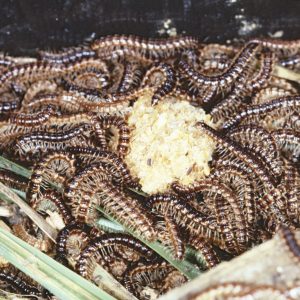
Figure 2. Garden millipedes eating dog food on a lawn.
Figure 3. Garden millipedes feeding on decaying plant material (CC-drnancyjackson-NC, iNaturalist).
Diet
Millipedes eat decaying organic matter, including all kinds of plant materials such as leaf litter, mulch, and grass thatch, and even eat pet food in lawns (Figures 2 and 3). Occasionally, such as when the soil in gardens and greenhouses gets too dry, they may eat the roots and shoots of plants to obtain moisture.
Habitat
Garden millipedes are nocturnal, preferring dark, cool, moist habitats that are rich in dead and decaying organic matter. They have no eyes and rely on their antennae to navigate. During the day, they remain inactive. When disturbed, they often coil and stay motionless.
Habitats that meet their environmental needs include flower beds, leaf piles, and potted plants; underneath stones, sidewalks, driveways, or concrete slabs, and inside logs (Figures 4, 5, and 6). They stay in relatively hidden places and need a lot of moisture because they are prone to drying out.
Millipedes breed in compost piles, leaf litter, rotting logs, or soil under rocks and potted plants. They often go unnoticed because of their inconspicuous habitats until huge numbers suddenly appear around and inside homes. Garden millipedes may become pests in greenhouses, where they can survive in otherwise inhospitable climates.
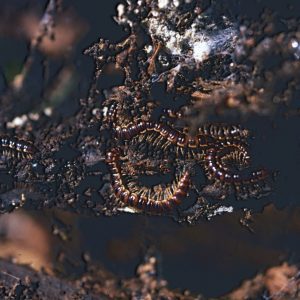
Figure 4. Garden millipedes in garden soil
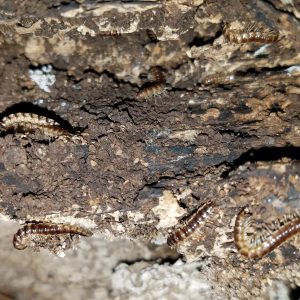
Figure 5. Garden millipedes inside a rotting log (CC-Leila Dasher-public domain, iNaturalist)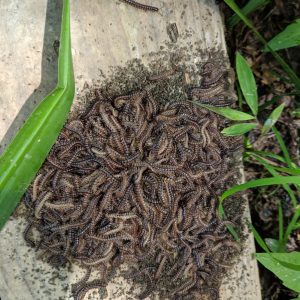
Figure 6. Garden millipedes congregating under a pot (CC-Hamilton Turner-public domain, iNaturalist)
Benefits
Millipedes are beneficial and essential to ecosystems in that they help decompose plant materials and return nutrients to the soil. They also have effectively established themselves in the food chain and serve as food for some reptiles, amphibians, birds, mammals, and predatory insects.
Drawbacks
Millipedes are not dangerous to humans or animals. They do not bite, sting, transmit disease, or cause structural damage. Their propensity to invade structures makes them a nuisance, however, especially when they invade homes and greenhouses in large numbers and then die. When threatened, millipedes release a liquid that has a foul odor and can irritate eyes and skin, and when crushed, the millipede’s liquid can stain fabrics. Wear gloves and protective eyewear, therefore, when handling them.
Millipedes typically do not feed on or damage plants unless the plants are already damaged or decaying. Minor feeding injuries may occasionally occur on tender plants in gardens and greenhouses, however.
Causes of Invasion
Too much or too little rain can make outdoor millipede habitats unsuitable. Heavy rain can flush thousands of millipedes out of their habitat in search of a moist but less-saturated environment. Unfortunately, they sometimes seek shelter in homes and buildings, resulting in hordes on patios, driveways, window wells, garages, crawlspaces, and basements (Figures 7 and 8).
Their biological behaviors may also cause mass migration. In late spring and early summer, they typically migrate to find mates (Figure 9).
There may also be a correlation between large numbers of garden millipedes and newly constructed homes and neighborhoods. During construction, materials such as wood scraps and stacks of bricks provide dark, moist refuges where populations can increase. New sod and mulched beds allow millipede populations to be hidden while they increase in size. After a year or two, and depending on the weather, their populations are so large that any change in weather, especially increased rainfall, induces migration.
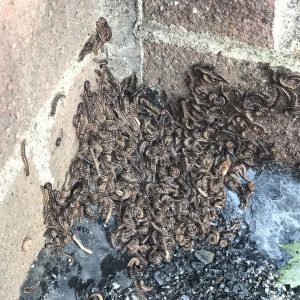
Figure 7. Garden millipedes aggregating at the corner of a building (CC-Mildlymistaken-NC-SA, iNauralist)
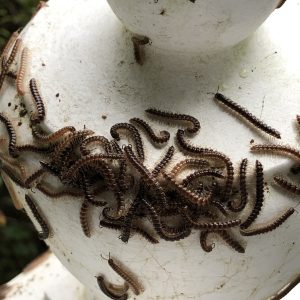
Figure 8. Garden millipedes clinging to a plaster post, probably for moisture (CC-Birdladymilam-NC, iNaturalist)
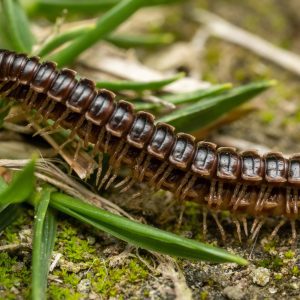
Figure 9. Garden millipede mating (CC-Jesse Rorabaugh-public domain, iNaturalist)
Control Methods
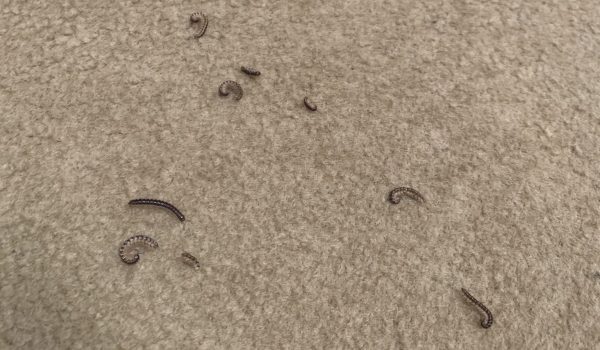
Figure 10. Dead garden millipedes on the carpet inside a house.
Despite their hard exoskeletons, millipedes are highly susceptible to drying out. They do not have an exterior coating of waterproofing wax as insects do. Normal indoor humidity that is comfortable for humans is too dry for millipedes; therefore, they desiccate and die rather quickly (Figure 10).
The most effective method for controlling millipedes is an Integrated Pest Management (IPM) approach. You may undertake your own IPM plan by implementing the control suggestions listed below, or you may choose to hire a professional pest control service. Some methods for control involve using chemicals; many others involve practices for preventing them from invading in the first place. It is important to note that spraying insecticides does little to reduce their numbers. Even if you kill the ones that are present, more millipedes may keep entering from outside. There are chemical controls that can be used; however, nonchemical methods for prevention work best.
Nonchemical Control Methods
Nonchemical practices include preventing access to structures, reducing moisture, and using traps. Exclusion is the best line of defense, preventing access into structures and reducing moisture and breeding sites in and around structures.
Prevent access to structures, using the following methods.
- Seal cracks and crevices in the walls and foundation where millipedes and other pests might enter. Use steel wool to block weep holes and fill large voids in walls, vents, and around drainpipes. Use caulk or foam to help keep the steel wool in place.
- Install weather stripping around door frames and ensure that door sweeps are in good condition. Ensure that no light is visible around the door.
- Caulk around windows, door frames, and thresholds.
- Direct any water runoff away from homes and structures to maintain a dry environment. Eliminate water accumulation from leaking pipes, irrigation, and air conditioning condensation to help reduce moisture in the immediate area.
- Water lawns and plants in the morning only to prevent pooling and excessive moisture.
- Keep the landscape free of leafy debris and grass clippings to eliminate millipede food sources and habitats. Dispose of organic material away from structures.
- Remove pet food that is not eaten by pets every evening as millipedes are known to feed on moist pet food.
- Mulch to a level no thicker than 2 to 4 inches.
- Dethatch the lawn to improve air flow and make the lawn less suitable for millipedes.
- Closely mow and edge the lawn so it can dry more quickly, further reducing millipede habitats.
- Keep trash cans, trash piles, water barrels, and potted plants away from the foundation, or raise them off the ground.
- Plant flowerbeds or gardens away from structures, crawlspaces, and basements.
- Remove rocks, logs, firewood, and other items from around foundations and throughout the yard.
- Keep basements and crawlspaces ventilated and dry by installing a dehumidifier and vents. Install a plastic vapor barrier to cover the soil in crawlspaces.
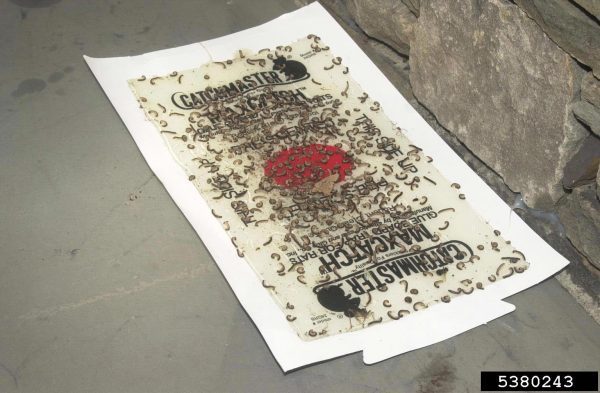
Figure 11. Dead garden millipedes on sticky board (Gary Alpert, Harvard University, Bugwood.org)
Since millipedes cannot live indoors for more than a few days, treatment inside the home or building is not necessary. The fastest and most appropriate control method is to sweep or vacuum them up and deposit the vacuum bag in an outdoor garbage bin.
Using sticky traps and glue boards is a safe way to catch and kill millipedes inside and outside (Figure 11). Set them in areas where millipedes frequently enter, such as near windows and doors, but in places out of reach of children and pets.
Chemical Control Methods
Pesticides are rarely, if ever, required unless millipedes continue to invade in large numbers after all nonchemical methods have been attempted. Always read instructions before applying chemicals and be sure to apply products consistent with label directions. Many insecticides labeled for millipede control are very toxic to fish.
There are many chemical products that are EPA-approved for millipede control. Outdoor applications are generally limited to spot or crack-and-crevice treatments to the base of structure walls around pest entry points. Read product labels for exception applications to the soil, foundations, and pervious surfaces. Rake back think layers of mulch to allow treatment of the exposed soil.
Wettable powders provide more extended residual activity. For outdoor applications with residual contact insecticides, products include Gamma-Cyhalothrin, dinotefuran, bifenthrin, cyfluthrin, lambda, or carbaryl. Do not apply these products directly to impervious horizontal surfaces, and do not treat more than 2 square feet at a time.
Homeowners may try applying diatomaceous earth (DE) powder directly to potential entry points. DE has been formulated in many products registered for use inside and outside buildings, gardens, and pet kennels. DE is not poisonous but causes insects to dry out and die by absorbing the cuticle’s oils, fats, and water. It remains effective if kept dry and undisturbed but must be reapplied after rain or irrigation. Be sure to wear a respiratory mask so you do not inhale the powder and damage your lungs.
Although the application of chemicals may sometimes help reduce the number of millipedes that are inside a building, it does not provide complete control during periods of heavy millipede movement. Creating and maintaining dry conditions are the best cure for millipede problems. Preventing access to structures, eliminating habitat, and properly managing irrigation will reduce the presence of these annoying invaders.
References
Appel AG. 1988. Water relations and desiccation tolerance of migrating garden millipedes (Diplopoda: Paradoxosomatidae). Environmental Entomology 17:463-466.
Appel AG. 2003. IPM of occasional urban invader pest species. Journal of Entomological Sciences. 38: 151-158.
Buipitt F. 2016. Congregating behavior and response to resource distribution of the Green House Millipede, Oxidus gracilis. PeerJ Preprints 4:e2642v1 https://doi.org/10.7287/peerj.preprints.2642v1
Kania G and Klapec T. 2012. Seasonal activity of millipedes (Diplopoda)–their economic and medical significance. Annals of Agricultural and Environmental Medicine. 19: 646-650. EPA website. Insecticides.
Original source can be found here.




 Alerts Sign-up
Alerts Sign-up